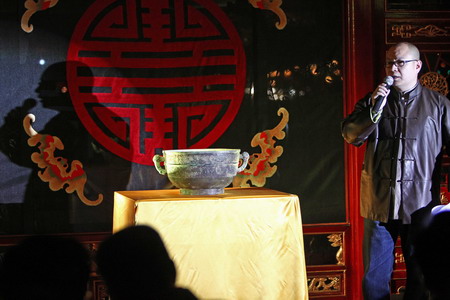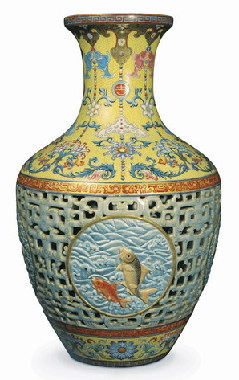Photos
For investors, glamorous bounty lies in looted treasures
Updated: 2010-12-15 09:32
By Cheng Yingqi (China Daily)
|
 |
|
A host introduces one of nine ancient bronze relics returned to China from abroad during a show in Beijing on Mar 20. The set cost a total of 300 million yuan to buy at auction. [Photo / Provided to China Daily] |
Could you spend $82 million in just 16 minutes?
One Chinese antique collector did last month with a winning bid at a London sale for an 18th-century Chinese vase.
|
 |
|
The Qing Dynasty (1644-1911) vase that fetched $82 million. Provided to China Daily |
"The room was packed with dealers from everywhere, but most were Chinese," recalled Peter Bainbridge, part owner of Bainbridge's, which auctioned the vase on Nov 12. "When I banged the hammer (to start the sale), the room was alive with excitement."
The artwork is the latest in a raft of relics that have returned to China thanks to big-money bids by the nation's nouveau riche.
Yet, although patriotism is playing a part in this hunt to recapture looted treasures, experts say the majority of buyers are in fact more interested in the investment potential of ancient works - and the glamour.
"Buying looted artwork has become high-street fashion among China's elite, especially in the past year," said Zhao Xu, director of Poly International Auction Co Ltd.
No official figure exists for the number of looted artworks bought back by rich Chinese, yet industry insiders say the market is booming.
In the past 13 months, at least 16 Chinese antiques have sold for more than 100 million yuan ($14.9 million) at domestic and overseas auctions - almost four times the total number between 2005 and 2009.
"As artworks inside China are rare, more are setting their sights on looted artwork abroad," explained Zhao.
Artifacts seldom go under the hammer on the Chinese mainland, with most already on display at museums nationwide.
However, estimates suggest that as many as 1.64 million looted Chinese relics are in the hands of 47 overseas museums, with another 16.4 million owned by individuals, according to a Xinhua News Agency report in 2009 that cited statistics from the United Nations Educational, Scientific and Cultural Organization.
"Exports of antique have been restricted since 1949, but before that some businesses and aristocracy in the Qing Dynasty (1644-1911) shipped large numbers of antiques overseas," said Sun Jie, marketing director of China Guardian Auctions.
|
||||
Sun Haifang began his mission to recover 33 Tang Dynasty (AD 618-907) celadon terracotta warriors in 2001 after learning they had been illegally sold to a Hong Kong entrepreneur.
After getting the buyer's phone number, the mainland collector called and managed to negotiate an initial 250-million-yuan deal for 18 warriors. To get the remainder took six years and another 500 million yuan.
Today, all 33 are on display at Sun's private museum in Shaoxing, Zhejiang province.
"Looking for Chinese antiques abroad is nothing new but it has become more heated (in recent years) and is attracting a lot of entrepreneurs to join the game," said auction house boss Zhao. "A lot of money is being spent."
Sun added that more than 80 percent of collectors in China are bidding for work related to traditional Chinese culture, such as ceramics, painting and calligraphy.
E-paper

Ear We Go
China and the world set to embrace the merciful, peaceful year of rabbit
Preview of the coming issue
Carrefour finds the going tough in China
Maid to Order
Specials

Mysteries written in blood
Historical records and Caucasian features of locals suggest link with Roman Empire.

Winning Charm
Coastal Yantai banks on little things that matter to grow

New rules to hit property market
The State Council launched a new round of measures to rein in property prices.




